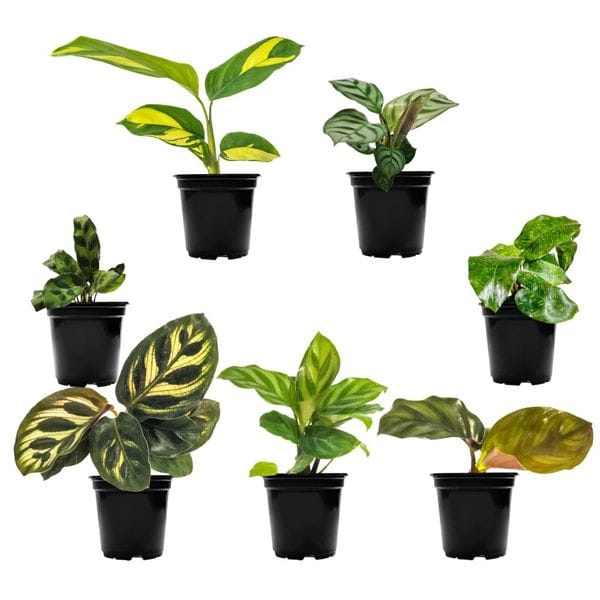Did you know that there are quite a few types of prayer plants? These incredible houseplants are not just easy to care for but also come in a stunning variety of types, each with its own unique charm.
In today’s article, we’re taking a journey through the enchanting world of different types of prayer plants. Whether you’re a seasoned gardener or a beginner, you can learn how to choose, grow, and enjoy these delightful plants.
From the classic Red Prayer Plant with its striking red veins to the playful Rabbit’s Foot Prayer Plant with its charming leaf patterns, there’s a prayer plant for everyone. We’ll introduce you to these green beauties, sharing tips on how to care for them, so they thrive in your home.
So, if you’ve ever wanted to bring a bit of the great outdoors into your living space, you’re in for a treat. Join us as we explore the wonderful world of prayer plants and discover how you can effortlessly enjoy their beauty and tranquility right at home.

Prayer Plant Types – What To Expect From Them
Prayer plants (Maranta species and related genera) have earned their place as some of the most captivating and sought-after houseplants. Renowned for their stunning foliage, intricate patterns, and the enchanting daily ritual of their leaves folding together in the evening, these plants have a devoted following among indoor gardeners.
However, what many may not realize is the incredible diversity within the prayer plant family, offering a rich tapestry of colors, patterns, and care requirements.
Here are the types of prayer plants, highlighting their unique characteristics and sharing valuable care tips.
1. Maranta leuconeura (Red Prayer Plant)
The Maranta leuconeura, or red prayer plant, is perhaps the most iconic of the prayer plant family. Its striking red veins against deep green leaves make it a favorite among plant enthusiasts. The foliage is elliptical, with an unmistakable central red vein running down the middle, creating a captivating contrast. It’s relatively easy to care for and makes an excellent choice for beginners.
2. Maranta leuconeura var. Kerchoveana (Rabbit’s Foot Prayer Plant)
Recognizable by its distinctive, rabbit’s-foot-shaped splotches on the leaves, this variety of Maranta leuconeura adds a playful touch to any indoor garden. Its striking foliage and moderate care requirements make it a popular choice for those looking to diversify their collection.
3. Calathea Ornata (Pinstripe Calathea)
Calathea ornata is a member of the broader Marantaceae family, known for its striking pinstripe-like patterns on its dark green leaves. Its unique foliage and air-purifying qualities make it a fantastic addition to any indoor space. However, it does have slightly higher humidity and care needs compared to some other prayer plants.
4. Calathea Medallion (Rose-painted Calathea)
The Calathea medallion is celebrated for its round, medallion-like leaves adorned with intricate patterns that resemble brushstrokes of pink and white. This variety requires a bit more attention to humidity levels but rewards growers with breathtaking foliage.
5. Calathea Orbifolia
Calathea orbifolia stands out with its large, rounded leaves featuring silver-green stripes. This plant makes a bold statement with its elegant, almost symmetrical appearance. It does well in moderate to high humidity environments and indirect light.
6. Ctenanthe Setosa (Fishbone Prayer Plant)
Ctenanthe setosa gets its nickname from the fishbone-like patterns that grace its leaves. Its distinctive foliage and moderate care requirements make it a delightful addition to prayer plant collections.
7. Stromanthe Triostar
Stromanthe triostar, a relative of the prayer plant family, showcases colorful variegated leaves with shades of pink, cream, and green. Its striking appearance and moderate care needs make it a popular choice for those seeking a touch of exotic beauty.
Choosing The Best Prayer Plant Varieties
The “best” prayer plant variety for your situation depends on several factors, including your specific environmental conditions, care level, and aesthetic preferences. Here are some recommendations for different situations:
1. Low Light Conditions
Maranta leuconeura (Red Prayer Plant): This classic variety can tolerate lower light levels, making it a great choice for spaces with limited natural light.
2. High Humidity
Calathea Ornata (Pinstripe Calathea): Calatheas, including the pinstripe variety, thrive in high humidity environments. They’re excellent choices for bathrooms or kitchens with good moisture levels.
3. Limited Care and Beginner Gardeners
Maranta leuconeura (Red Prayer Plant): Red prayer plants are relatively forgiving and suitable for beginners. They require regular but not overly complex care.
4. Small Spaces or Hanging Planters
Ctenanthe Burle-Marxii (Fishbone Prayer Plant): This variety has a compact growth habit and is well-suited for small spaces or hanging planters due to its cascading foliage.
5. Aesthetic Appeal and Showpiece
Calathea Medallion (Rose-painted Calathea): If you’re looking for a prayer plant that doubles as a decorative centerpiece with its unique leaf patterns, the Calathea Medallion is an excellent choice.
6. Variegated Foliage and Colorful Displays
Stromanthe Triostar: With its variegated leaves featuring shades of pink, cream, and green, the Stromanthe Triostar adds a pop of color to your indoor garden.
7. Personal Preference
Sometimes, your choice of prayer plant variety may come down to personal preference and the specific look or vibe you want to create in your space. Trust your instincts and go with the variety that resonates with you.
Wrap Up
Regardless of the one you choose, make sure to provide the necessary lighting, humidity, and watering conditions to help it flourish. Each variety has its own unique charm, so explore and enjoy the diversity of prayer plants as you create a lush and captivating indoor garden.